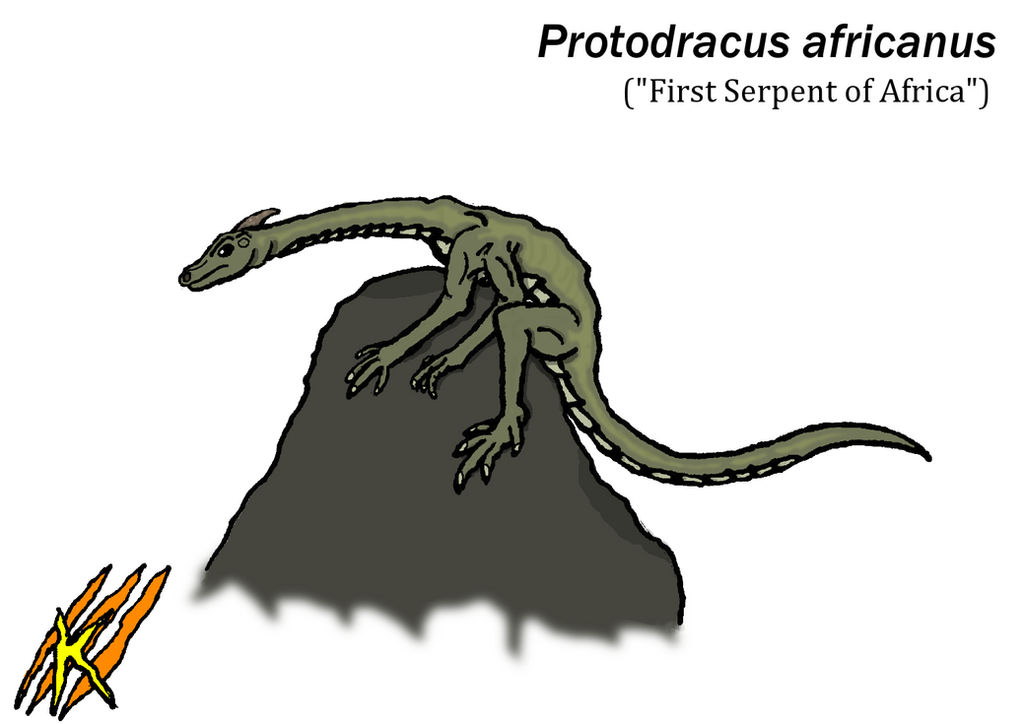Deviation Actions
Description
Protodracus africanus (First Serpent of Africa)
Kingdom: Animalia
Phylum: Chordata
Class: Reptilia
Order: Protosauria
Suborder: Protodracomorpha
Family: Protodracidae
Genus: Protodracus
Physical Description: Roughly 2.5 meters long (8 feet), roughly 20-25 kg estimate (44-55 lbs)
Location: Modern-day South Africa
Diet: Presumed omnivore with carnivorous tendencies, opportunistic scavenger
Description: Protodracus was an archosauromorph that existed during the late Permian Period in what is today South Africa. It is among the earliest known archosaur-like animals as well as one of the earliest known dragon ancestors if not 'the' dragon ancestor. The species has a number of traits that sets it apart from other archosaurs though it still largely retains the same build as their early fellows.
Likely believed to have evolved from a common ancestor to the protorosaurs due to a shared physical build, the earliest protodracus fossils did not include the extra set of limbs. The oddity did not occur until roughly the beginning of the Permian Extinction Event, whereby the fossils were discovered to have been buried near scattered deposits of uranium and radium ore. It is believed that, perhaps either due to a meteor strike or due to volcanic activity, the local populations of the species were exposed to enough of the substance that a few mutations began to occur, though the only one that seemed to stay with the species for overly long was the extra set of limbs. As time went by and as the region became steadily more volcanic and unstable the mutation began to outnumber those that weren't mutated, suggesting that it later became an adaptation in response to the constant shifting in the Earth's crust.
Due to their close linkage to other archosaurs the protodracus proved to be a specialist in survivability. Its powerful tail could double as a paddle, allowing it to swim competently in the water in order to escape from danger. Its long neck could be used to acquire food from an extended range and keep it from being exposed to danger. Its claws were well suited for grabbing tough surfaces, making it an ideal climber on various forms of terrain; with the extra pair of limbs likely providing a buffer in the event that pieces of the terrain begin to fall away due to the instability of the ground. One final adaptation discovered includes a swelling in the area where normally such animals would have a gall bladder, suggesting that it was heavily pronounced inside of protodracus. This is likely an adaptation to allow for the consumption of meat that had been heavily bathed inside of the toxic salts that fell alongside ash clouds from volcanoes or meteor strikes, allowing for a wider palette of available food.
------------------------------------------------------------------------------------------------------------
Been meaning to make this for a while. I had thought up a while ago that something I really wanted to try and do was make a sort of natural history encyclopedia of various animals of mythology; either for a fantasy project or just for fun. Having a stab at what others of arguably more credible knowledge have done before; namely explaining through science how an animal like a dragon could have lived; has been one of my little hobbies that I've had for a while but never really took further than just a few notes on MS Word.
Probably the biggest obstacle to explain a dragon is why they have the extra set of limbs. Vertebrates naturally have only about four limbs total whereas most arthropods have an average of around 8-10+ depending on the species. While some fish have an extra set of fins none of the ones that we know of today were included among our immediate ancestors, and even if they did they likely would have done away with the needless set a long time ago (if you've ever seen the makeup of the Tiktaalik reconstruction you'd see what I mean; it's likely that even if it's ancestor could have had another pair of fins they were disposed of due to the lack of necessity in having an extra set of limbs for a job that only required four). One way that Animal Planet solved this problem via their "Dragons - A Fantasy Made Real" documentary was by explaining that during the Cretaceous extinction event marine dragons developed a mutation that evolved an extra set of limbs...though their reasoning was by no means sound and was only half-baked as a way to save film time. My personal explanation, and one that I like, was that during the early Permian a species likely had become exposed to some form of toxic radiation; nothing too catastrophic as to ruin them, but enough to force their DNA to begin to mutate wildly, including having embryos grow an extra set of limbs. When the working limbs proved to be useful (such as clinging tightly to a branch or a rock while the rest of your world is literally falling apart beneath your feet) the species began to incorporate that into their greater genepool rather than get rid of it, creating a worthy adaptation rather than a baneful mutation.
There are other obstacles to explain, of course; how they could have flown, how they breathed fire, how big they could get and what they had to hunt in order to survive; but I'll save those for another entry in this series. Until then, enjoy!
-Kerian
P.S. I seriously need a working tablet...-n-
















![Karzahni [8940]](https://images-wixmp-ed30a86b8c4ca887773594c2.wixmp.com/f/aba88067-1608-411f-bb14-be0b87bd843b/daajek6-ba998fe5-cf3a-4d67-8415-f0f4f303af90.jpg/v1/crop/w_92,h_92,x_8,y_0,scl_0.02662037037037,q_70,strp/karzahni__8940__by_krytenmarkgen_0_daajek6-92s.jpg?token=eyJ0eXAiOiJKV1QiLCJhbGciOiJIUzI1NiJ9.eyJzdWIiOiJ1cm46YXBwOjdlMGQxODg5ODIyNjQzNzNhNWYwZDQxNWVhMGQyNmUwIiwiaXNzIjoidXJuOmFwcDo3ZTBkMTg4OTgyMjY0MzczYTVmMGQ0MTVlYTBkMjZlMCIsIm9iaiI6W1t7ImhlaWdodCI6Ijw9NzY4IiwicGF0aCI6IlwvZlwvYWJhODgwNjctMTYwOC00MTFmLWJiMTQtYmUwYjg3YmQ4NDNiXC9kYWFqZWs2LWJhOTk4ZmU1LWNmM2EtNGQ2Ny04NDE1LWYwZjRmMzAzYWY5MC5qcGciLCJ3aWR0aCI6Ijw9MTAyNCJ9XV0sImF1ZCI6WyJ1cm46c2VydmljZTppbWFnZS5vcGVyYXRpb25zIl19.rx-Yuo8uj3sPReHttfuRdAFoyF5C3aKMtUy1xyQakJo)

![Nidhiki [8622]](https://images-wixmp-ed30a86b8c4ca887773594c2.wixmp.com/f/aba88067-1608-411f-bb14-be0b87bd843b/dbqfa1z-0b423ac4-1f9e-474a-8d41-ccfe74464579.jpg/v1/crop/w_92,h_92,x_8,y_0,scl_0.02662037037037,q_70,strp/nidhiki__8622__by_krytenmarkgen_0_dbqfa1z-92s.jpg?token=eyJ0eXAiOiJKV1QiLCJhbGciOiJIUzI1NiJ9.eyJzdWIiOiJ1cm46YXBwOjdlMGQxODg5ODIyNjQzNzNhNWYwZDQxNWVhMGQyNmUwIiwiaXNzIjoidXJuOmFwcDo3ZTBkMTg4OTgyMjY0MzczYTVmMGQ0MTVlYTBkMjZlMCIsIm9iaiI6W1t7ImhlaWdodCI6Ijw9NzY4IiwicGF0aCI6IlwvZlwvYWJhODgwNjctMTYwOC00MTFmLWJiMTQtYmUwYjg3YmQ4NDNiXC9kYnFmYTF6LTBiNDIzYWM0LTFmOWUtNDc0YS04ZDQxLWNjZmU3NDQ2NDU3OS5qcGciLCJ3aWR0aCI6Ijw9MTAyNCJ9XV0sImF1ZCI6WyJ1cm46c2VydmljZTppbWFnZS5vcGVyYXRpb25zIl19.A2gfdFX4rnrH0fJbv7ZB2oPjiK2EowYczg_1LRoxJ20)















![Karzahni [8940]](https://images-wixmp-ed30a86b8c4ca887773594c2.wixmp.com/f/aba88067-1608-411f-bb14-be0b87bd843b/daajek6-ba998fe5-cf3a-4d67-8415-f0f4f303af90.jpg/v1/crop/w_184)

